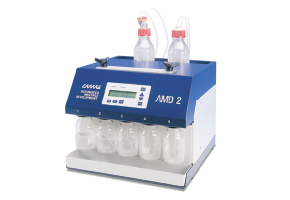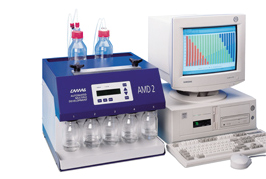AMD 2
Development & Derivatization
Extending the reach of TLC using gradient elution

Automated Multiple Development of Thin-Layer Chromatograms
The CAMAG AMD 2 (Automated Multiple Development) procedure allows Thin-Layer Chromatography to be utilized for tasks that could not be performed by TLC in the past. The use of gradient elution gives up to three times the separation power of standard HPTLC, with increased precision and reliability.
In gradient elution the HPTLC plate is developed repeatedly in the same direction, varying the eluent strength each time to give a stepwise elution gradient. This technique results in extremely narrow bands, enabling more components to be resolved, as well as reducing analysis time.

- Gradient elution gives greatly increased separation, especially of samples that cannot be easily separated by isocratic methods because of their wide range of retention properties.
- Fully automatic operation through the entire program with data input and monitoring through the winCATS software.
- Flexible match with 5 solvents
- Automatic saturation, method, migration distance and dryness with parameters
- Internal CCD sensor to monitor the development process and show the migration distance and time
- Compliant with the requirements of GLP / cGMP and 21 CFR Part 11
- Clinical applications
- Food and Feedstuffs
- Pharmaceutical applications
- Herbals
- Cosmetics
- Industrial applications
- Forensics
- Environmental